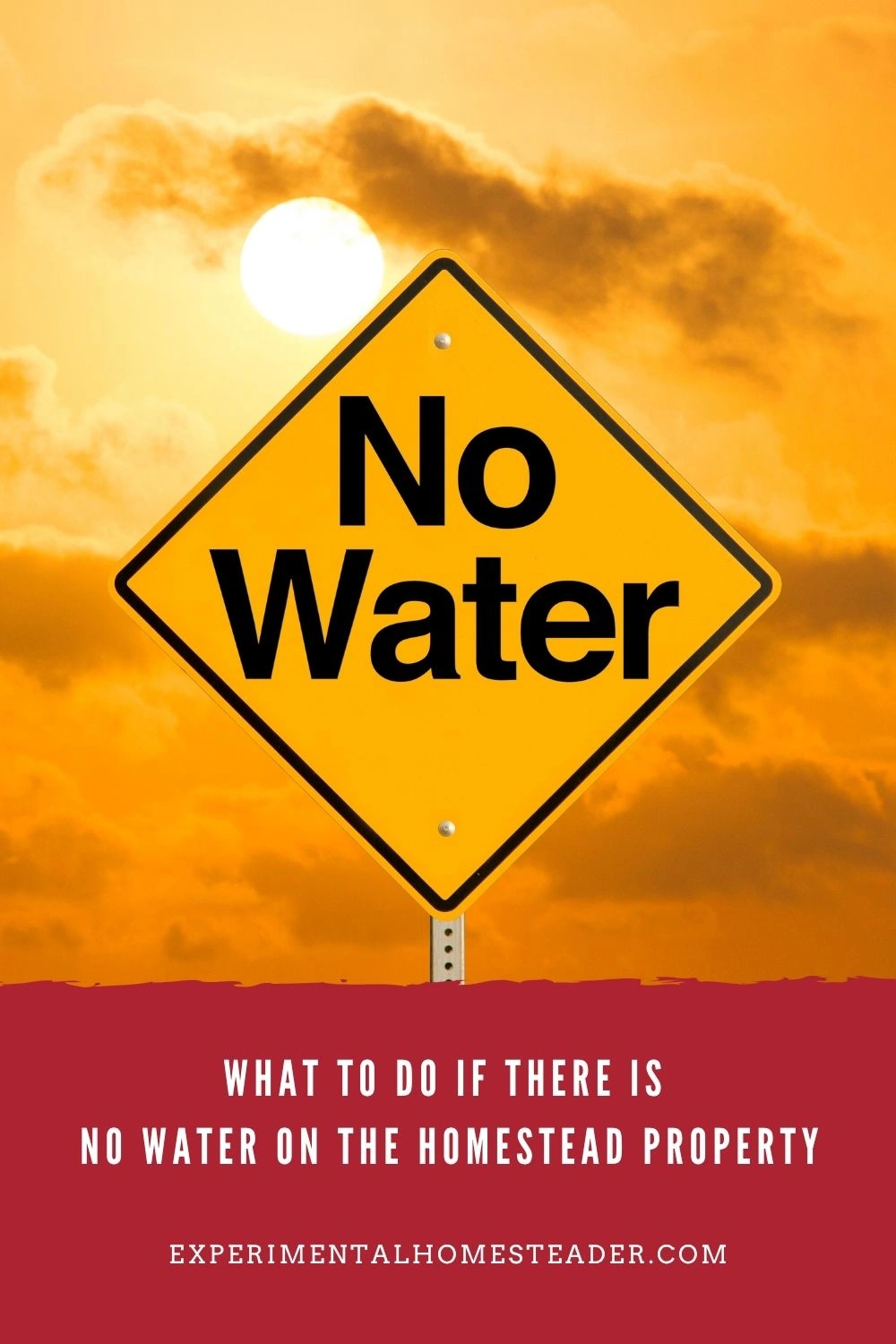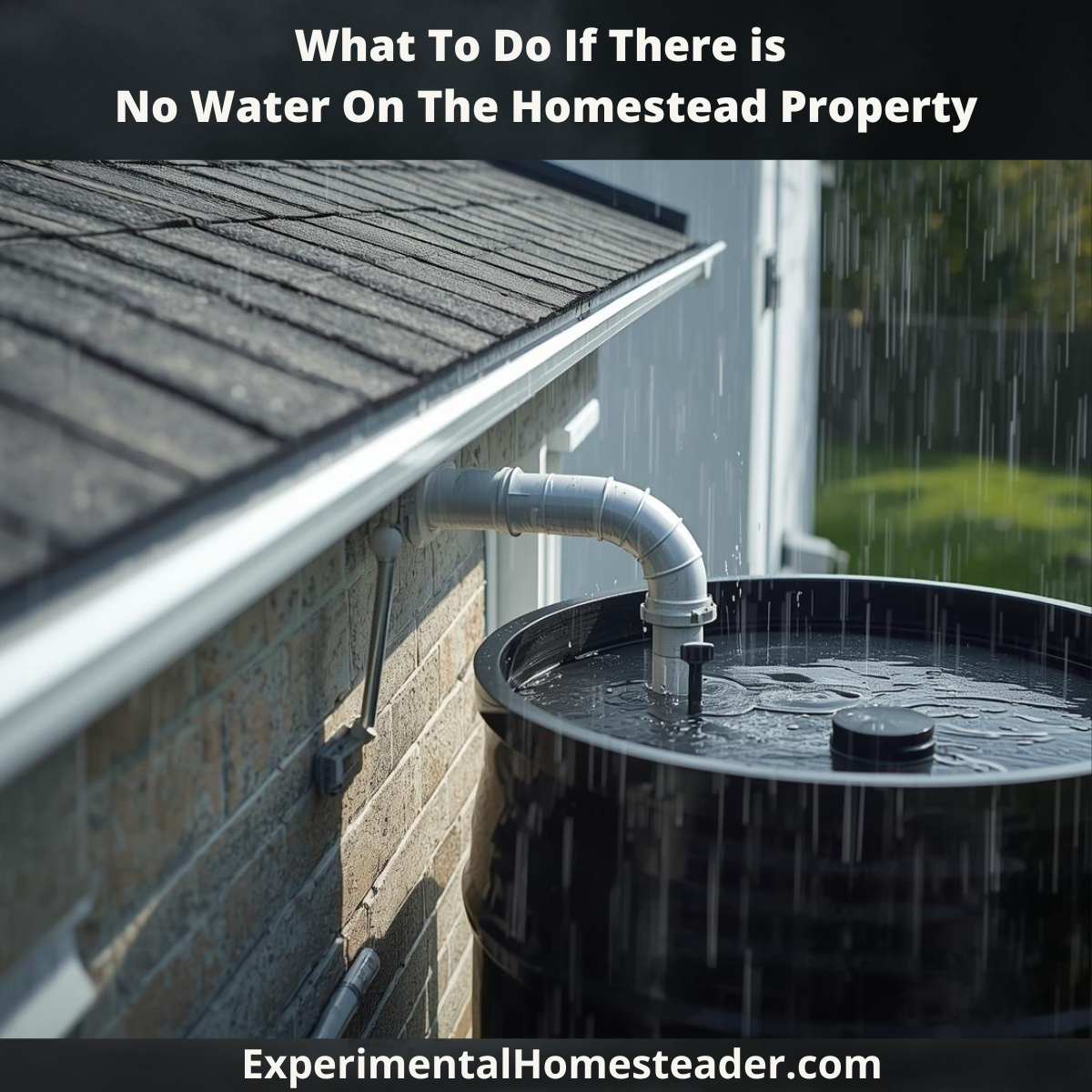Discovering there’s no water on the homestead property can stop you in your tracks.
After all, water is one of the first essentials we think about when dreaming of a self-sufficient life.
Without it, how will you grow food, care for animals, or even take a shower after a long day of chores?
I get it - finding out your new slice of paradise doesn’t have running water can feel like the end of the dream.
But here’s the truth: it’s not.
Many successful homesteads began on land without a single drop flowing from a faucet.
The difference comes down to creativity, planning, and a willingness to adapt.
From cisterns and wells to rainwater collection and ponds, there are solutions for nearly every property.
In this post, we’ll explore your best options, how to make them work, and what to consider before you buy or build.
When Your Dream Property Comes Without Running Water
You’ve finally found it - the piece of land that calls your name.
Maybe it’s tucked along a quiet gravel road, with a few old trees, a barn that’s seen better days, and just enough acreage to build the homestead you’ve been dreaming about.
But then comes the catch: there’s no water on the property.
Your stomach sinks.
You picture all the things you can’t do - no garden irrigation, no hot showers, no water for the animals.
Before you give up, take a deep breath.
Many homesteads started out the exact same way.
Lack of water doesn’t mean your land isn’t worth it - it just means you’ll need to plan carefully and think outside the box.
Let’s walk through your options and what to consider before you make your next move.
Step One: Find Out What’s Really Going On
The first thing to do is gather real information about your potential water situation.
Talk to neighbors.
Ask the county or township if there’s a record of a water line nearby or if a well was ever dug on the property.
Some older homesteads have a well or cistern that’s simply been neglected over time.
If you’re lucky, the property might have had access to city water at one point, even if the previous owners never hooked it up.
Sometimes, especially in rural neighborhoods, water lines were run through years ago, but connecting to them was costly - or the homeowner just didn’t want a monthly bill.
If the line still exists, all you may need is a connection and a new pipe run from the road to your house.
Yes, there are fees involved, but this is often the simplest and most dependable fix.
Just make sure to get a written estimate for the work and confirm that the pressure is good enough to handle household and garden use.
Step Two: Check for an Old Cistern
If city water isn’t available, your next question should be whether there’s a cistern on the property.
A cistern is a large underground reservoir, typically made of brick, stone, or concrete.
Decades ago, before rural water systems existed, cisterns were the lifeline for many homesteads.
These were designed to collect and store rainwater or to tap into underground springs.
Over time, many have fallen out of use, but you’d be surprised how many old ones still exist - sometimes hidden under a patch of grass or an old outbuilding.
If you find one, have it inspected for structural soundness and cleanliness.
Cisterns can be restored, sealed, and put back into service.
Paired with modern filtration, UV purification, or even a gravity-fed system, they can provide a reliable water supply year-round.
One of the biggest perks of having a cistern is independence - you control your water and aren’t at the mercy of monthly utility bills or main line failures.
Step Three: Consider Drilling a Well
Drilling a well is another common and often long-term solution.
However, this can be a bit of a gamble, depending on your location and geology.
Wells can cost anywhere from a few thousand dollars to well over $10,000, depending on how deep you have to go to reach water.
Before drilling, contact your local extension office or the Department of Natural Resources to learn about water table depths and any restrictions in your area.
Sometimes, older properties have a capped or dry well that could be rehabilitated with professional help.
The nice thing about having a well is the security it brings - you know that as long as your pump and power are working, you’ll have water.
Just remember to plan for off-grid contingencies, such as adding a hand pump or solar pump system if you want to ensure access during power outages.
Step Four: Build a Pond or Small Reservoir
For those going completely off-grid or living in areas where wells aren’t practical, a pond or small reservoir can serve as both a scenic and functional water source.
Ponds can supply water for livestock, gardens, and even home use if treated properly.
You’ll need to check your local zoning laws and possibly obtain permits for excavation, but this option can be an incredible long-term investment.
Ponds also help control runoff, create a wildlife habitat, and can even provide a backup water source during droughts.
Of course, pond water can be muddy and mineral-heavy, so it will require good filtration and possibly a UV or chlorination setup if you plan to use it for household needs.
Still, for many homesteaders, having that glimmering pond on the back of the property feels like pure freedom.
Step Five: Capture and Store Rainwater
If you’re homesteading in a region that gets decent rainfall, rainwater harvesting and storage can be one of your best options.
With the right setup - gutters, downspouts, and large storage tanks - you can collect thousands of gallons per year.
For every inch of rain that falls on 1,000 square feet of roof, you can collect about 600 gallons of water.
That adds up quickly!
Rainwater collection systems can be simple or complex:
-
Basic setup: Gutters connected to barrels or tanks with a mesh filter to keep out debris.
-
Advanced system: Multiple tanks connected to a cistern with sediment filters and a pump for household pressure.
This water can be used for washing clothes, watering the garden, cleaning, and - if properly filtered - even drinking.
The key here is storage capacity.
During dry spells, your tanks can run empty fast, so always plan for a backup option - whether that’s hauling water, a small well, or a pond.
Step Six: Think About Animal Watering Systems
Once you’ve got water for the house figured out, think about your animals.
Watering livestock can be one of the biggest daily challenges on a property without running water.
Here are a few ideas that work well:
-
Use gravity-fed tanks or tote setups for smaller livestock like goats and chickens.
-
For cattle or horses, consider a frost-free hydrant near your pond or cistern.
-
If hauling water, install large storage tanks near barns or pastures so you only have to fill them once or twice a week.
And don’t underestimate the importance of a good winter plan.
Heated buckets, tank de-icers, or solar-powered trough heaters can make a world of difference when temperatures drop.
Step Seven: Understand the Costs and Long-Term Maintenance
Whatever system you choose - city hookup, well, cistern, pond, or rain collection - remember that water infrastructure comes with ongoing maintenance.
Pipes can freeze, pumps can burn out, and filters need to be changed regularly.
Water lines, especially those buried underground, typically need to be replaced every 15 to 20 years.
And leaks can be expensive if you’re on city water - the water company might forgive one or two large bills caused by a broken pipe, but after that, you’re on your own.
That’s why it’s crucial to design your system with accessibility and sustainability in mind from day one.
A little preventative maintenance goes a long way.
Step Eight: Plan Before You Buy or Build
If you’re still in the property-hunting stage, make water your first question before you get attached.
It’s easy to fall in love with the view or the price, but water availability can make or break your homesteading dream.
Ask these questions early on:
-
Is there an existing well, cistern, or pond?
-
How deep are neighboring wells, and what’s the water quality like?
-
Is city water available, and how far would you have to run the line?
-
Are there any local water rights or restrictions that could affect collection or use?
Knowing these answers before closing will save you time, money, and frustration later.
Step Nine: Combine Systems for Resilience
One of the smartest strategies for long-term water security on a homestead is redundancy - having more than one way to get water.
For example:
-
Use rainwater collection as your main source but keep a small cistern for emergencies.
-
Pair a well with a pond, so you can alternate depending on conditions.
-
Or, have city water for household use and rainwater or pond water for gardens and livestock.
The more options you have, the less likely you’ll be caught off-guard during a drought, power outage, or equipment failure.
Step Ten: Embrace the Mindset of Resourcefulness
This brings us to the heart of homesteading - it’s not just about having everything perfect from the start.
It’s about being resourceful, adaptable, and willing to learn.
When you’re standing on that dry land, wondering how you’ll ever make it work, remember: every established homestead once started from scratch.
Someone, somewhere, had to figure out how to get water flowing for the first time.
You’re simply walking in those same footsteps.
The challenge of having no water on the homestead property can actually become a blessing in disguise.
It pushes you to design a smarter, more sustainable system right from the beginning.
You’ll understand every valve, every pipe, and every tank because you built it yourself -or supervised the process every step of the way.
And when that first trickle of water runs through your line, or when your cistern fills after a good rain, you’ll feel an overwhelming sense of pride.
You made it happen.
You didn’t give up.
Living Proof: Water Is Worth the Work
I’ve known homesteaders who started with nothing more than a dry patch of land and a big dream.
They dug cisterns, hauled water in 250-gallon totes, and built elaborate rain-catching systems out of old barrels.
It wasn’t glamorous, but it worked - and each season, they made small improvements.
One couple I met rigged a gravity-fed shower using a 55-gallon drum perched on a hill behind their cabin.
Another built a homemade sand-and-charcoal filtration system that produced surprisingly clear water.
These aren’t just stories - they’re proof that creativity and determination can turn even the driest property into a thriving homestead.
So, if you’re facing the reality of no water on the homestead property, don’t let it discourage you.
Instead, see it as the beginning of your education in true self-sufficiency.
Water Isn’t Just a Resource - It’s Your Foundation
In the end, water is life.
It’s the foundation of your garden, your animals, and your home.
But it’s also a teacher.
Learning to manage it wisely - whether through wells, rain barrels, or ponds - will deepen your understanding of the land itself.
Your homestead’s success won’t depend on luck or convenience.
It’ll depend on your willingness to observe, adapt, and build systems that work with nature instead of against it.
So, don’t walk away from a property just because it doesn’t have running water.
Take the time to assess your options, plan your systems, and build something truly sustainable.
Because once you’ve secured your water source, everything else - gardens, livestock, and even peace of mind - will flow naturally from there.








